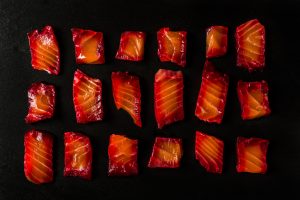The mysteries of chocolate and its captivating powers are something we might never fully understand. Sure there are scientists that can tell us how complex sugars within the cacao might trigger synapses to fire in a certain way, but our love of chocolate seems much more primal.
The cocoa bean originates from South America, but is now cultivated throughout the Caribbean, in many African countries on the west coast of the continent as well as Madagascar, Sri Lanka and Indonesia. As you might expect, the cocoa industries in many of these locations have been somewhat questionable, which is why responsible sourcing organisations like Fairtrade are so important. There are in fact chocolate producers that go above and beyond the remit for Fairtrade too – something certainly worth your attention when selecting your base ingredients.
There are three types of cocoa bean; Criollo, Forastero, and Trinatario. Forastero is the most common, and cheapest variety of cocoa. Criollo is seen as the most prized variety and offers up a complex range of flavours including bright fruity acidity, as well as caramel notes and wafts of smokey tobacco. Meanwhile the Trinatario bean is a hybrid of the two originating from Trinidad, and is now perhaps the main cocoa bean found in medium to high-end chocolate bars.
Our love of cocao and its wide and varied uses has seen a huge level of adulteration over the years. However, now more than ever, we are seeing widespread appreciation of dark, high percentage chocolate. ‘Bean-to-bar’ is now very much a thing, where companies handle every part of the production process, taking cacao beans from their natural state and leaving the end consumer with a ready to eat product. In the kitchen we are also seeing more diverse use of chocolate.
While chocolate lava cake and Black Forest gateaux are still all round crowd pleasers, the intense flavours of dark chocolate are being used in a number of interesting ways such as being utilised for in-house charcuterie cures, and an increasing involvement in savoury main course dishes.
The flavours of the cocoa bean have found affinity in spices for a long time, partnering remarkably with fruity chillies like the Habanero and Scotch Bonnet, but also with the dry heat of black pepper corns and the tart punch of sumac. Purists may say that the cocoa should stand alone without adulteration, and this is sometimes a calling for using it to add flavour to foods on it’s own, without secondary seasoning. Dark chocolate has been added casseroles, curries and chillis for a while, adding complexity and richness to already complicated dishes, but freshly grating over a seared loin of venison, or some paper thin bressaola can be pretty darn transcendent. This scenario often works in reverse, the umami rich, irony depth of the meat helping to elevate the natural flavour profile of the chocolate.
Whether you feel a strong pull towards heavily sweetened chocolate dishes, or steer more towards the dark, bitter and obscure, the range of flavours pulled from cocoa are immense and the versatility of this remarkable ingredient makes it one of the most valued ingredients in the chef’s pantry.


